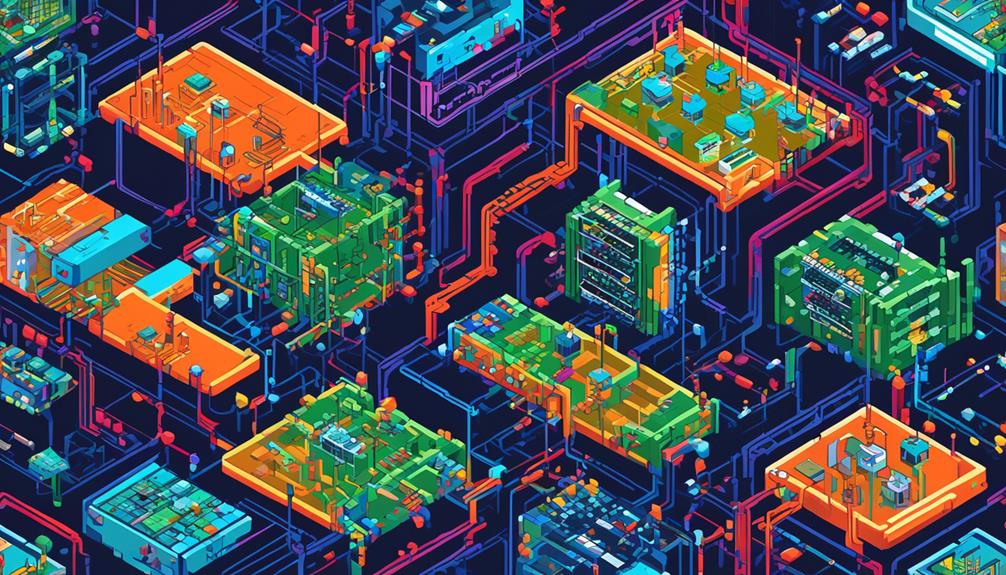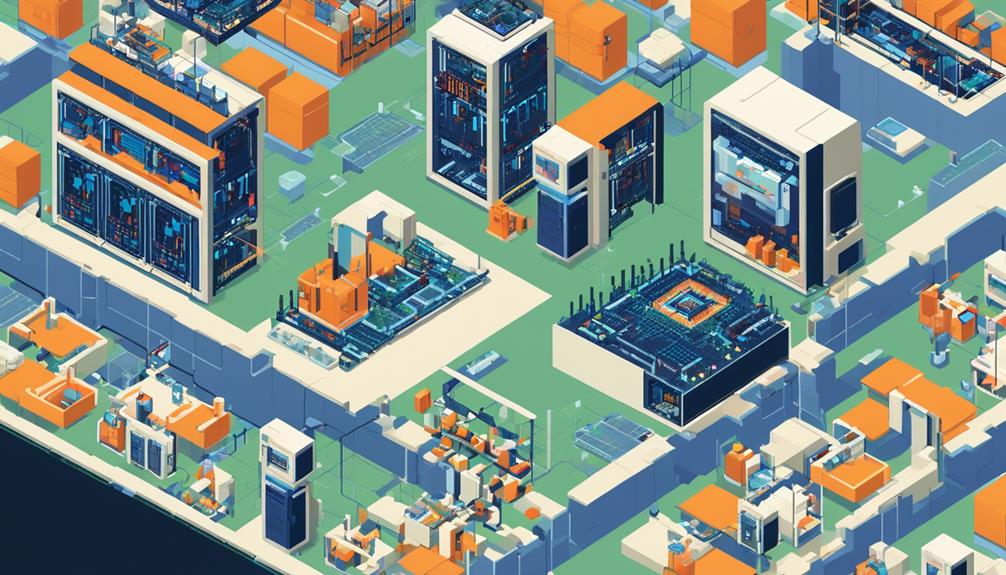As the world eagerly anticipates the full-scale deployment of 5G networks, there is a growing need to understand the intricacies of the hardware that will power this revolutionary technology.
5G hardware encompasses a wide range of components and systems, each playing a crucial role in delivering the promised benefits of faster speeds, lower latency, and increased connectivity. From antennas and radio frequency components to small cell technology and advanced beamforming techniques, each aspect of 5G hardware holds the key to unlocking the full potential of this next-generation wireless technology.
In this discussion, we will delve into the fundamental aspects of 5G hardware, exploring its network architecture, integration with the Internet of Things (IoT), and the security measures employed to safeguard this cutting-edge technology.
So, let us embark on a journey to unravel the intricate world of 5G hardware and discover what you need to know to stay ahead in the 5G era.
Key Takeaways
- 5G network architecture consists of the Radio Access Network (RAN) and the Core Network, with base stations, antennas, and core network nodes as key components.
- Small Cell Technology improves network coverage in densely populated areas, but deployment challenges include managing interference and securing power and backhaul connectivity.
- Security measures for 5G hardware include authentication, encryption, network slicing, continuous monitoring, and threat detection systems.
- Massive MIMO systems and beamforming techniques increase network capacity and spectral efficiency, with analog and digital beamforming offering different advantages.
5G Network Architecture

The design and organization of a communication network using the G technology standard is known as G Network Architecture. It encompasses the arrangement of network elements such as base stations, antennas, and core network nodes for the transmission of data and voice services.
G Network Architecture consists of two main components: the Radio Access Network (RAN) and the Core Network.
The RAN is responsible for wireless communication and includes base stations and radio network controllers. Base stations, also known as cell sites, are equipped with antennas that transmit and receive signals to and from mobile devices. These base stations are strategically placed to ensure optimal coverage and capacity. The radio network controllers manage and control the base stations, coordinating the transmission and reception of signals within the network.
The Core Network, on the other hand, handles the switching, routing, and data processing functions for user communication. It is responsible for managing the flow of data between different base stations and facilitating communication between mobile devices and external networks. The Core Network also provides additional services such as authentication, billing, and security.
G Network Architecture aims to provide high-speed data transmission, low latency, and efficient connectivity for both mobile and fixed devices. By optimizing the arrangement and configuration of network elements, G Network Architecture ensures seamless communication within the wireless network. It enables users to access a wide range of services such as voice calls, video streaming, and internet browsing with minimal disruptions.
Antennas and Radio Frequency Components
Antennas and radio frequency components play a crucial role in the functionality of 5G hardware.
Antenna design considerations, such as gain, directivity, and impedance matching, are essential for optimal signal reception and transmission.
Additionally, the integration of radio frequency components, including amplifiers, filters, and mixers, is necessary for processing and manipulating radio frequency signals in 5G networks.
Antenna Design Considerations
When designing antennas for 5G hardware, several factors must be carefully considered. These factors include the frequency of operation, impedance matching, radiation pattern, polarization, and environmental conditions.
- Frequency of operation: The frequency at which the antenna operates determines its size and shape. Higher frequencies require smaller antennas, while lower frequencies require larger ones.
- Impedance matching: It is crucial to ensure that the antenna's impedance matches that of the radio frequency components. This ensures maximum power transfer and efficient operation.
- Radiation pattern: The radiation pattern of an antenna dictates how energy is radiated in three-dimensional space. Different applications may require specific radiation patterns, such as omnidirectional or directional.
- Polarization: The orientation of the electric field of the electromagnetic wave is known as polarization. Matching the polarization of the antenna with that of the transmitting or receiving device is essential for optimal performance.
Considering these factors, along with environmental conditions such as temperature, wind, and moisture, is vital when designing antennas for 5G hardware. By carefully considering these considerations, engineers can ensure efficient and reliable communication in the 5G network.
RF Component Integration
RF component integration is a crucial aspect of designing efficient and reliable wireless communication systems. Antennas play a critical role in RF component integration by transmitting and receiving radio frequency signals. Additionally, various radio frequency components such as filters, amplifiers, and mixers are integrated to process RF signals, enhancing or altering their characteristics. To ensure optimal performance, impedance matching, signal isolation, and noise management must be carefully considered during the integration process. The layout of antennas and other RF elements must be designed and optimized to facilitate efficient signal propagation and reception. Proper RF component integration is essential for wireless communication systems, enabling seamless connectivity and reliable signal transmission.
| Key Concepts | Description |
|---|---|
| Antennas | Transmit and receive RF signals for wireless communication. |
| RF Components (filters, amplifiers, mixers) | Process RF signals to enhance or alter their characteristics. |
| Impedance Matching | Ensures maximum power transfer between RF components. |
| Signal Isolation | Prevents interference between different RF components. |
| Noise Management | Minimizes unwanted signals or disturbances in the RF system. |
| Layout Optimization | Designing the arrangement of RF elements to optimize signal propagation and reception. |
| Reliable Signal Transmission | Ensures seamless connectivity and reliable wireless communication. |
Small Cell Technology

Small Cell Technology offers several benefits for wireless networks. These include improved coverage in densely populated areas and the ability to offload data traffic from macrocell networks. However, deploying small cells can present challenges. These challenges include the need for a large number of installations and the complexity of managing interference in crowded environments. Understanding both the benefits and challenges of small cell deployment is crucial. This understanding is crucial for optimizing network performance and ensuring seamless connectivity in the 5G era.
Benefits of Small Cells
The implementation of small cell technology offers significant benefits in enhancing network capacity and coverage, particularly in densely populated areas and venues with high data demand. Here are four key advantages of small cells:
- Improved network performance: Small cells offload traffic from macro cells, reducing congestion and improving data speeds. This leads to a better user experience and faster download/upload speeds.
- Enablement of 5G technology: Small cells play a crucial role in deploying 5G networks, providing enhanced mobile broadband and supporting the Internet of Things (IoT) connectivity.
- Cost-effective solution: Small cells are a cost-effective way to expand network coverage and capacity, especially in areas where macro cell deployment is challenging. They offer a more affordable alternative to building new macro cell towers.
- Easy integration: Small cells can be easily integrated into existing infrastructure, such as streetlights and utility poles. This makes them less obtrusive and aesthetically pleasing while providing the necessary network coverage.
Furthermore, small cells often come equipped with Ethernet ports, allowing for seamless connectivity and integration with other network devices and services.
Deployment Challenges of Small Cells
After discussing the benefits of small cells, it is essential to address the deployment challenges associated with this technology.
Small cells require careful placement to ensure optimal coverage and capacity. This involves identifying suitable locations and determining the number of small cells needed in each area.
Power and backhaul connectivity must be secured for each small cell deployment to ensure continuous operation and data transmission.
Interference management is crucial to avoid signal degradation between small cells and optimize network performance.
Additionally, regulatory compliance and local zoning regulations can pose challenges for small cell deployment, as it may require obtaining permits and approvals.
Coordinating with existing infrastructure and obtaining site access may also require negotiation and planning.
Overcoming these deployment challenges is crucial for the successful implementation of small cell technology.
Massive MIMO Systems
Massive MIMO systems, with their ability to employ a large number of antennas for simultaneous serving of multiple users, play a crucial role in enhancing wireless network capacity and spectral efficiency. Here are four key aspects of massive MIMO systems:
- Increased Capacity: By using a large number of antennas, massive MIMO systems can serve multiple users simultaneously. This increases the overall capacity of the wireless network, allowing more users to connect and transmit data without experiencing congestion or degradation in performance.
- Spectral Efficiency: Massive MIMO systems benefit from spatial multiplexing, which allows multiple data streams to be transmitted in the same frequency-time resource. This technology maximizes the utilization of available spectrum, increasing spectral efficiency and enabling higher data rates for users.
- Signal Processing Challenges: Handling the large number of antennas and user channels in massive MIMO systems requires advanced signal processing algorithms. These algorithms must efficiently process and separate the signals from different users, while mitigating interference and maintaining high-quality communication.
- Future of Wireless Communication: Massive MIMO systems are a key technology for 5G networks and future wireless communication systems. As the demand for higher data rates and capacity continues to grow, massive MIMO provides a scalable solution that can meet these requirements and support the increasing number of connected devices.
Beamforming Techniques

Beamforming techniques are an essential component of wireless communication systems, enabling the precise directionality of signals for improved performance and reliability. By focusing the transmission and reception of signals towards specific directions, beamforming reduces interference, improves signal strength, and extends coverage in wireless networks. This technology is commonly used in Wi-Fi routers, cellular base stations, and other wireless communication devices.
There are two main types of beamforming techniques: analog beamforming and digital beamforming. Each type has its own advantages and limitations.
Analog beamforming utilizes phase shifters to adjust the phase of the signals transmitted or received by each antenna. This technique is simpler and less computationally intensive than digital beamforming. However, its main limitation is that it cannot dynamically adapt to changing channel conditions.
Digital beamforming, on the other hand, uses complex signal processing algorithms to control the amplitude and phase of the signals at each antenna. This allows for more precise control over the directionality of the beams and enables adaptive beamforming. Digital beamforming can dynamically adjust to changing channel conditions and optimize the signal quality. However, it requires more computational resources and is more complex to implement.
The following table provides a comparison of analog beamforming and digital beamforming techniques:
| Analog Beamforming | Digital Beamforming | |
|---|---|---|
| Implementation Cost | Low | High |
| Complexity | Low | High |
| Adaptability | Limited | High |
| Signal Quality | Good in static conditions | Optimized for changing channel conditions |
| Computational | Less computational resources required | More computational resources required |
Edge Computing Infrastructure
Edge computing infrastructure plays a crucial role in enabling efficient and low-latency data processing at the source of data generation. By processing data closer to where it is generated, edge computing infrastructure reduces latency, improving real-time decision making.
Here are four key facts about edge computing infrastructure:
- Components: Edge computing infrastructure includes servers, storage, networking, and software deployed in edge locations. These components work together to process and analyze data at or near the edge, minimizing the distance data needs to travel to centralized data centers.
- Use Cases: Edge computing infrastructure supports a wide range of use cases, including IoT devices, industrial automation, and critical applications that require low latency and high bandwidth. For example, in manufacturing plants, edge computing can enable real-time monitoring and control of production processes, optimizing efficiency.
- Security Enhancements: Edge computing infrastructure enhances security by processing sensitive data locally, closer to the source. This reduces the need for transmitting data to centralized data centers, minimizing the risk of data breaches during transmission. It also enables organizations to maintain better control over their data since it remains within their own infrastructure.
- Lower Costs: Edge computing infrastructure can also lead to cost savings. By processing and analyzing data at the edge, organizations reduce the amount of data that needs to be transmitted and stored in centralized data centers. This can result in lower bandwidth and storage costs, as well as reduced network congestion.
Virtualization and Software-defined Networking

Virtualization and software-defined networking (SDN) are crucial technologies in the context of 5G hardware. Network virtualization offers benefits such as optimized resource usage, scalability, and flexibility in deploying and managing network resources.
On the other hand, SDN provides centralized network management and automation, simplifying network configuration and troubleshooting. By leveraging the synergies between virtualization and SDN, 5G networks can achieve efficient resource utilization, enhanced network agility, and improved responsiveness.
Network Virtualization Benefits
The benefits of network virtualization, particularly when combined with software-defined networking (SDN), are evident in their ability to enhance network efficiency, flexibility, and scalability. Here are four key benefits of network virtualization:
- Cost savings: Network virtualization allows for the consolidation of multiple virtual networks onto a single physical network infrastructure, reducing hardware costs and maximizing resource utilization.
- Improved security: By creating isolated virtual networks, network virtualization provides enhanced security and isolation between different applications and user groups, minimizing the risk of unauthorized access and data breaches.
- Simplified management: Abstracting network resources from the underlying hardware simplifies network management, allowing for easier configuration and provisioning of networks. This streamlines operations and reduces the complexity associated with managing physical networks.
- Rapid deployment of services: By creating virtual networks with specific requirements, network virtualization enables the rapid deployment of new services and applications without impacting the underlying physical infrastructure. This agility allows organizations to quickly respond to changing business needs.
Software-Defined Network Advantages
Network virtualization benefits extend to software-defined networking (SDN), which offers distinct advantages in terms of network management and flexibility. SDN separates the control plane from the data plane, allowing for easier management and configuration of network resources. This is achieved through the use of virtualization, which enables the creation of virtual networks that can be easily managed and reconfigured.
SDN also provides centralized network management, making it easier to implement and enforce policies across the network. This centralized approach allows for dynamic allocation and adjustment of network resources based on demand, leading to improved scalability and efficiency. Additionally, SDN can lead to cost savings by enabling the use of lower-cost, commodity networking hardware and reducing the need for manual configuration and management.
The following table illustrates the advantages of software-defined networking:
| Advantages | Description |
|---|---|
| Easier management and configuration | Separation of control and data planes allows for simplified network management and configuration. |
| Centralized network management | Provides a centralized approach to implement and enforce policies across the network. |
| Scalability and cost savings | Dynamic allocation of network resources based on demand leads to improved scalability and cost savings. |
Virtualization and 5G Synergy
The integration of virtualization and 5G technology fosters enhanced efficiency and flexibility in network management through the utilization of software-defined networking (SDN). This synergy enables network operators to optimize resource utilization and rapidly deploy services by creating virtual network functions within the 5G infrastructure.
Here are four key benefits of virtualization and 5G synergy:
- Dynamic resource allocation: By leveraging virtualization and 5G synergy, network operators can dynamically allocate resources based on demand, ensuring optimal utilization and improved network performance.
- Service scalability: Virtualization allows for the scaling of services in response to changing requirements, ensuring that the network can accommodate evolving needs.
- Network slicing: Virtualization and 5G synergy facilitate the implementation of network slicing, enabling the support of diverse services with varying requirements over a single physical network infrastructure.
- Agility and cost-effectiveness: This synergy plays a crucial role in the evolution towards next-generation networks, enabling the delivery of innovative services and applications with improved agility and cost-effectiveness.
Through virtualization and 5G synergy, network management becomes more efficient, flexible, and capable of meeting the demands of modern communication networks.
Network Slicing for Different Use Cases

Network slicing enables the creation of multiple virtual networks on a single physical infrastructure, allowing for tailored network services to meet the specific requirements of diverse industries and use cases. By allocating resources based on specific needs, network operators can optimize network performance and efficiently utilize resources, leading to improved user experiences and cost savings.
Network slicing is a key enabler for 5G networks, providing the flexibility and scalability needed to support a wide range of use cases and applications. It allows network operators to customize network services to meet the needs of different industries, including healthcare, transportation, and manufacturing.
To better understand the concept of network slicing and its benefits, let's take a look at the following table:
| Use Case | Specific Requirements | Network Slice |
|---|---|---|
| Healthcare | Low latency, high reliability | Slice with prioritized traffic and QoS |
| Transportation | High bandwidth, low latency | Slice with dedicated resources for real-time communication |
| Manufacturing | High reliability, low latency | Slice with guaranteed uptime and low latency |
| Video Streaming | High bandwidth, low latency | Slice with ample bandwidth and optimized for video streaming |
As shown in the table, network slicing allows for the creation of virtual networks tailored to different use cases. Each slice can be optimized to meet specific requirements, ensuring that the network performance aligns with the needs of the industry or application.
Internet of Things (IoT) Integration
With the foundation of network slicing in place, the next topic of discussion is the integration of Internet of Things (IoT) devices into 5G networks. IoT integration involves connecting various devices to the internet, enabling them to communicate and share data. This integration is highly beneficial as it allows for remote control and monitoring, leading to increased convenience and efficiency in various fields such as smart homes, healthcare, agriculture, and manufacturing.
To delve deeper into IoT integration in 5G networks, here are four key points to consider:
- Enhanced Connectivity: 5G networks provide faster and more reliable connectivity, which is crucial for IoT devices to transmit and receive data seamlessly. The increased capacity and lower latency of 5G networks enable real-time communication and data exchange between IoT devices.
- Secure Communication: As IoT devices handle sensitive data, secure communication protocols are imperative to protect data privacy and integrity. 5G networks offer robust security measures, such as authentication and encryption, to ensure that IoT devices are securely connected and data is safeguarded.
- Compatibility and Software Development: Integrating IoT devices into 5G networks may require compatibility checks to ensure that devices are compatible with the network infrastructure. Additionally, software development may be necessary to create applications and interfaces that enable effective communication and control of IoT devices.
- Network Configuration: Proper network configuration is essential for seamless integration of IoT devices. This involves optimizing network parameters, allocating resources efficiently, and managing network traffic to accommodate the diverse requirements of IoT devices.
Security Measures for 5G Hardware

To ensure the secure operation of 5G hardware, various security measures are implemented to protect against unauthorized access and safeguard data transmission. One of the key security measures for 5G hardware is the implementation of encryption protocols. These protocols ensure that data transmitted over 5G networks is encrypted, making it difficult for attackers to intercept and decipher the information.
In addition to encryption, secure boot mechanisms are employed to prevent unauthorized firmware and software from running on 5G devices. This ensures that only authorized and trusted software is executed, reducing the risk of malware and other malicious code compromising the security of the hardware.
To enhance device security, hardware-based authentication methods are utilized in 5G hardware. Biometric sensors, such as fingerprint scanners or facial recognition technology, provide an additional layer of security by verifying the identity of the user. Secure elements, which are tamper-resistant hardware components, are also integrated into the devices to securely store sensitive information and prevent unauthorized access.
Physical attacks and unauthorized access are further mitigated through the integration of tamper-resistant hardware components in 5G hardware. These components are designed to resist tampering, making it difficult for attackers to gain physical access to the device and extract sensitive information.
To address potential vulnerabilities, robust remote management and security patching capabilities are implemented in 5G hardware. This allows for timely updates and patches to be deployed, addressing any security vulnerabilities that may arise and ensuring the continued security of the hardware.
Frequently Asked Questions
What Is Basic Hardware Knowledge?
Basic hardware knowledge encompasses understanding the fundamental components and terminology of computer systems. It involves knowing about the motherboard, CPU, RAM, PSU, and video card, as well as their respective functions and interconnections.
Additionally, familiarity with troubleshooting techniques for identifying and replacing faulty hardware components is essential. This knowledge enables individuals to effectively diagnose and resolve hardware-related issues, ensuring optimal performance and functionality of computer systems.
What Are the 5 Main Hardware?
Hardware essentials refer to the fundamental components that are crucial for the functioning of a computer system. These include the motherboard, CPU, RAM, PSU, and video card.
The motherboard acts as the central hub, coordinating and connecting all other hardware.
The CPU, or central processing unit, interprets and executes most commands.
RAM serves as the computer's memory, while the PSU supplies power.
The video card handles graphics and videos.
Understanding these five main hardware components is essential for anyone looking to gain a comprehensive knowledge of computer systems.
What Are the 4 Types of Computer Hardware?
There are four main types of computer hardware components: the motherboard, CPU, RAM, and PSU.
The motherboard acts as the central coordination point for all other hardware components.
The CPU, or central processing unit, is responsible for interpreting and executing most commands.
RAM, or random access memory, is the computer's temporary storage space.
The PSU, or power supply unit, provides the necessary power for the computer to operate.
These hardware components work together to ensure the smooth functioning of a computer system.
How to Learn About Computer Hardware?
To learn about computer hardware and gain knowledge in hardware hacking, individuals can explore various resources.
- Online tutorials, books, and courses provide in-depth information on computer components, their functions, and how to troubleshoot and repair them.
- Practical experience through hands-on projects and experimentation is also crucial for understanding hardware concepts.
- Additionally, joining forums and participating in communities dedicated to hardware hacking can facilitate learning through discussions and shared experiences.
- Continuous research and staying updated with the latest hardware developments are essential in this field.
